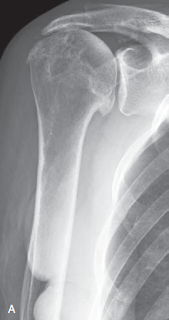Cuff tear arthropathy (CTA) can be defined as the combination of a large, irreparable rotator cuff tear and glenohumeral arthritis. In this condition, the humeral head is typically superiorly decentered with respect to the scapula
The lack of the centering effect of the normal rotator cuff puts a prosthetic glenoid component at risk for rocking horse loosening
in which the superiorly decentered humeral head differentially loads the superior aspect of the glenoid component, prying it away from the bone
The prosthetic options for managing disabling cuff tear arthropathy include a reverse total shoulder arthroplasty (RSA, below left, see this link) and, for selected patients, a cuff tear arthropathy hemiarthroplasty (CTAH, below right, see this link).
The CTAH can be a good option for the active patient with cuff tear arthropathy and the ability to actively elevate the arm above the horizontal. See this case for example (link).
The CTAH cannot be effectively used in a patient with pseudoparalysis (inability to actively raise the arm) or anterosuperior escape as shown below
The authors of Managing rotator cuff tear arthropathy: A role for cuff tear arthropathy hemiarthroplasty as well as reverse total shoulder arthroplasty demonstrated that - for appropriately selected patients - each of these procedures can be effective in the management of cuff tear arthropathy. They retrospectively reviewed 103 patients with CTA treated with shoulder arthroplasty, the type of which was determined by the patient's preoperative ability to actively elevate the arm. Outcome measures included the change in the Simple Shoulder Test (SST), the percent maximum improvement in SST (%MPI), and the percentage of patients exceeding the minimal clinically important difference (MCID) for the change in SST and %MPI.
Both arthroplasties resulted in clinically significant improvement.
56% of the 103 patients were managed with RSA. Patients having RSA improved from a mean preoperative SST score of 1.7 to a postoperative score of 6.3 (p<0.01). Instability accounted for most of the RSA complications. The improvements in the 12 individual functions of the Simple Shoulder Test are shown below.
44% of the 103 patients were managed with CTAH. Patients having CTAH improved from a preoperative SST score of 3.1 to a postoperative score of 7.6 (p<0.001). Instability did not occur in any of the CTAH patients. The improvements in the 12 individual functions of the Simple Shoulder Test are shown below.
Comment: It is apparent that the cuff tear arthropathy hemiarthroplasty provides a robust surgical alternative to RSA for active patients with cuff tear arthropathy having preoperative active elevation above the horizontal.
In the treatment of cuff tear arthropathy, the CTA hemiarthroplasty can provide a safe and cost-effective alternative to RSA for patients with retained active elevation.
You can support cutting edge shoulder research that is leading to better care for patients with shoulder problems, click on this link.
Follow on twitter: https://twitter.com/shoulderarth
Follow on facebook: click on this link
Follow on facebook: https://www.facebook.com/frederick.matsen
Follow on LinkedIn: https://www.linkedin.com/in/rick-matsen-88b1a8133/
Here are some videos that are of shoulder interest
Shoulder arthritis - what you need to know (see this link).
How to x-ray the shoulder (see this link).
The ream and run procedure (see this link).
The total shoulder arthroplasty (see this link).
The cuff tear arthropathy arthroplasty (see this link).
The reverse total shoulder arthroplasty (see this link).
The smooth and move procedure for irreparable rotator cuff tears (see this link).
Shoulder rehabilitation exercises (see this link).







